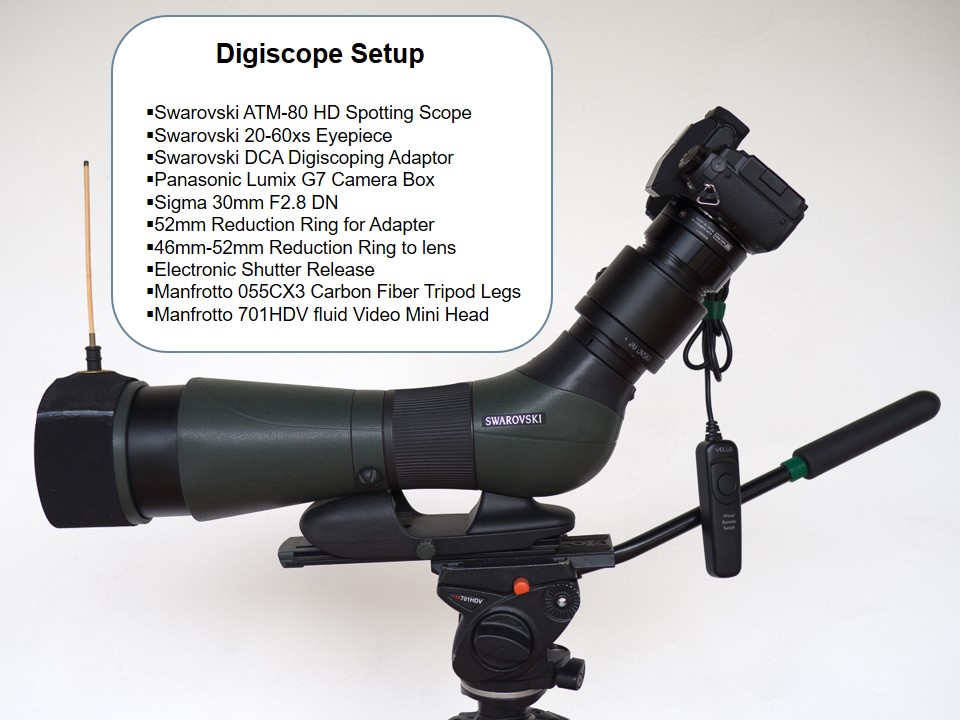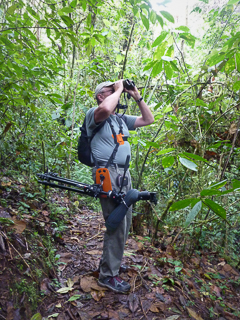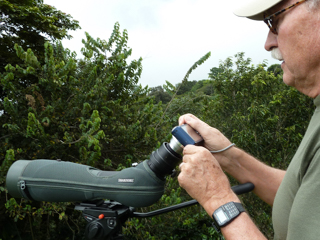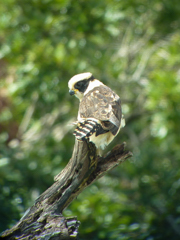Equipment
Digiscope bird photography is basically the use of a digital camera to take photos of birds through a spotting scope. It is a less expensive way to get telephoto images without buying very expensive long camera lenses. Most birders use a spotting scope to see more distant birds and more details on birds. We bought our spotting scope in early 2009 and started taking it on birding adventures. Spotting scopes are always used with a tripod. I had an old heavy Bogen tripod I used for the scope. The first camera I held up to the scope eyepiece was a point-and-shoot Panasonic DMC-ZS3. The first bird photo I took was of a Laughing Falcon about 300 feet away in an old dry tree on our farm. I found it challenging to hold the camera in the right position to get a good image and there was a lot of vignetting of the photo.(black circle aroung the outter edge). Here is what the rig looked like and the first photo. With some cropping I got rid of the vinetting and came up with a good image (click on the final photo to see a larger image).
For several months I took a lot of bird photos with this setup. Here is how it worked: 1. Get the scope and tripod set up and focused on a bird. Hopefully done before the bird flies away. It takes some practice to get on the bird quickly. 2. Hold the camera up to the eyepiece and try to get it carefully positioned over the eyepiece of the scope for a full image. 3. Wait for the bird to pose the way you want it. Hopefully it won't fly away. 4. Press the shutter and try to get a good photo. I would typically take a number of photos before one looked decent. It was tedious work. By the time you get set up the bird and the birders may have taken flight and you now lag behind everything. You have to lug the equipment again and try to catch up with the birders. They are often complaining that you missed the special one they were viewing.
I eventually realized that I might be able to make some sort of adapter to fasten the camera to the scope in a quicker and more consistent manner. I joined a couple of forums dedicated to digiscoping and tapped into a lot of useful information. I discovered there were other cameras and lenses that could do a better job. There also were some adapters being made to connect the cameras to the scopes. I decided to buy a Nikon P6000 and ready made adapters. This led to a decided improvement in setting up for the photos and getting full images with no vinetting. I also discovered, again by trial-and-error, that using a shutter release cable yielded better sharper images. I upgraded from the heavy Bogen tripod to a lighter Manfrotto carbon fiber tripod. All of this led to my first really good digiscope system. You can check it out here. In retrospect, I think the Nikon P6000 helped me get some of my best images.
One of the other challenges of digiscope photograpy of birds is carrying all the equipment. I would mostly carry the tripod with all the attached gear on my shoulder. This became stressful as the hours of birding wore on. I eventually decided to use a Stihl weedeater harness as a sling allowing me to carry the tripod, scope and camera for long periods of time with ease all ready to set up. My hands were also free to use the binoculars along the trails. This made lugging the equipment easier and more tolerable even on long birding day excursions. You can see the details of this sling system here.
Later, I developed a system using the Nikon V1 camera which delivered very good images with a farther reach. With this setup I had to fabricate my own shutter release bracket as there were none commercially made. See here.
I tried using an Olympus E-M10 camera but didn't have much luck with it. I finally asked Neil Fifer, an accomplished photographer and digiscoper that I met via a digiscope forum, what lens would work best with a Panasonic Lumix G7 camera box that I had. He was very helpful and recommended that I try the Sigma 30mm 2.8 DN lens. This worked like a charm and led me to the digiscope setup that I still use to this day. Here is it's composition:

When I started digiscoping in 2009, there were no books on the subject and there was little to no mainstream equipment dedicated to digiscoping. There are now many resources. In the links section you will find some of these resources. A recent development in digiscoping is the use of iPhones with a scope adapter that can produce some impressive images. I highly recommend that if you are interested in pursuing the digiscope adventure that you download the free book by Jerry Jourdan: Digiscoping from Start to Print and take a look at the videos in the links section. You can learn a lot from all of this and avoid all the trial-and-error that I experienced.
I used to conceptualize digiscoping as "the poor man's bird photography." I never thought I could realistically afford a full-size camera box and a big telephoto lense. Digiscoping allowed me to engage in the hobby at an affordable price. A spotting scope of good quality has never been inexpensive but it was and is a lot less money than a quality 800mm Nikon or Cannon lense which doesn't have the range that the digiscope system has. The main limitations of the digiscope are the fixed light (no adjustable apperture with scopes) and the need for a fixed platform (tripod). Most of my photos have been take with an ISO 200 and the camera lense wide-open. This makes digiscoping moving/flying birds near impossible although there are some digiscopers who do get some good photos of moving birds.
I eventually added a Nikon D7200 and a Nikon AF-S Nikkor 80-400 f/4.5-5.6G ED VR lens to my arsonal. I now realize the advantages of a camera and lens system over a digiscope. I also know the advantages of the digiscope in getting long shots. If I were a young man and could afford it I would have a good quality digiscope system and a good quality camera with a long lens in my tool kit. I have seen great images from both types of systems but frankly, the very best bird images I have ever seen come from good camera with long lense systems.
Post Processing
I manage my photography with Adobe Lightroom and Photoshop. I shoot most of my images in RAW format and then post process the images. I am more of a minimilist with post processing my bird photography. I am not trying to make cute artistic pictures. I want to make the bird image look as close to what I saw when I snapped the shutter in nature.
I make adjusments to cropping, light, saturation, sharpening and noise reduction as needed rather than paint an unrealistic artistic picture or grossly manipulated image.

Loaded and Ready to Shoot
One of the challenges with digiscoping is lugging all the equipment around in the brush and quickly getting it set up to grab that photo. /p>
It helps to be at least one half pack-mule and the other half eagle-eye.


